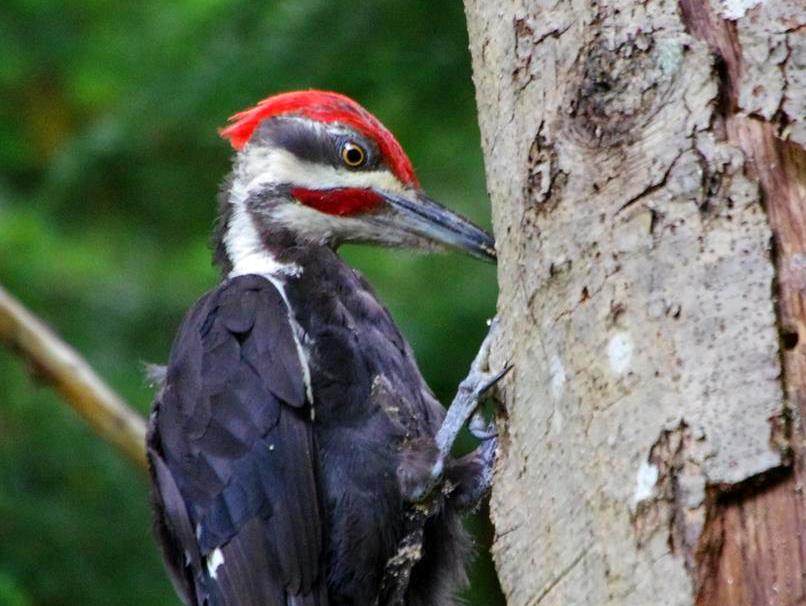Moose (Alces alces)
Moose are majestic giants who move quietly through the forest, rarely giving themselves away with a sound, but rather drawing your eye to their large shadowy figure.
Photo by Ryan Hagerty, USFWS
Why they Matter to Us
Moose
Are an important part of their ecosystem and influence the developing forest around them.
Are majestic attractions that draw visitors to Canada's parks and wildlands to view and study nature.
Have played a key role in the lives of First Nations People and provide large amounts of food for aboriginals and other hunters.
How You Can Help
Support protected areas in the Edmonton region (such as EALT!). You can donate or volunteer your time to help with conservation efforts. EALT's natural areas contain excellent moose habitat. Moose have been spotted on our remote wildlife cameras at Glory Hills, Boisvert's GreenWoods, and Ministik. We have also observed moose living at Golden Ranches, Smith Blackburn Homestead, and Hicks.
Keep your distance when you spot a moose. Moose are most likely to trot away when alarmed, but have been known to charge humans, especially during mating season (September to October) or when they are with their young in the Spring.
Modify your barbed wire fence to meet wildlife friendly standards. This will ensure moose of all ages and condition can easily cross your fence. You can also volunteer to help EALT remove hazardous barbed wire from our natural areas to improve wildlife habitat.
Reduce the chance of a vehicle collision with moose using the following tips:
Use your high beams at night, when possible, to make the moose's eyes glow so you can see it well in advance.
Scan the road and ditches ahead for animals, especially when travelling at dawn or dusk.
Slow down around curves, and at the crest of a hill. Reduce your speed at night when driving on unfamiliar roads, or roads lined with trees.
Brake firmly if a moose runs out in front of the vehicle - avoid swerving.
How to Identify
Identify by Sight
Curious moose checking out our Glory Hills Wildlife Camera
Moose stand 6–7 feet at the shoulder and weigh up to 600 Kg.
They're the largest member of the deer family.
Both males and females have a shoulder hump and a loose fold of skin hanging from their throats, called a dewlap or bell.
Only males have large palm shaped antlers, which are shed every year in November or December. Keep an eye out and you may come across some one day!
Identify by Sign
Moose leave several conspicuous signs that they were in the area
Large, elongated teardrop-shaped footprints (larger than a deer's print)
Large oval-shaped droppings (much larger than deer droppings)
A “browse line” about 4 – 8 feet from the ground where they have nibbled on shrubs and trees
“Beds” – flattened vegetation or depressions in the snow where they’ve stopped for a rest.
Identify by Sound
There are many different kinds of moose vocalizations. Some sound like horns or trumpets, while others sound like loud squealing. Usually they differ according to gender and purpose, like a female mating call vs. bugling, for example.
Click here to listen to a wide variety of moose sounds.
Where to Find
In Alberta, moose are common in most eco-regions except prairie. They prefer muskeg, and shrubby meadows as well as treed habitat close to lakes, ponds, or streams where they can feed on aquatic plants, willows, and shrubs.
Photo by Dan Spangenburg
EALT Wildlife Camera - Glory Hills
Social Life
Moose usually give birth to one calf, but twins are born up to 30% of the time.
Calves are able to swim soon after birth, so mom will sometimes swim to an island to give birth, where they are safe from predators.
Moose calves stay with their mom until she calves again the following spring.
Food Chain
In the summer, a large moose eats 25 - 30 kg (55 - 66 lbs) each day, feeding on aquatic plants, willows, shrubs, twigs and leaves.
In the winter, a large moose eats 15 - 20 kg (33 - 44 lbs) of twigs and shrubs each day. Moose restrict their food intake during the winter and limit their activity to save energy. As food becomes scarce closer to spring, they will eat bark from trees.
Moose are prey to bears, wolves, cougars, and calves are also prey for wolverines.
Fun Facts
Moose have terrible eye sight but make up for it with their heightened sense of hearing and smell.
Moose calves gain weight faster than any other large North American animal. In their first month, they gain half a kg a day, and later in the summer, gain 2 kg/day!
A moose calf can outrun a human and can swim when its just a few days old!
A bull's antlers can stretch as much as 1.8 m (6') from tip to tip, and together both may weigh up to 40 kg (88 lbs).






































